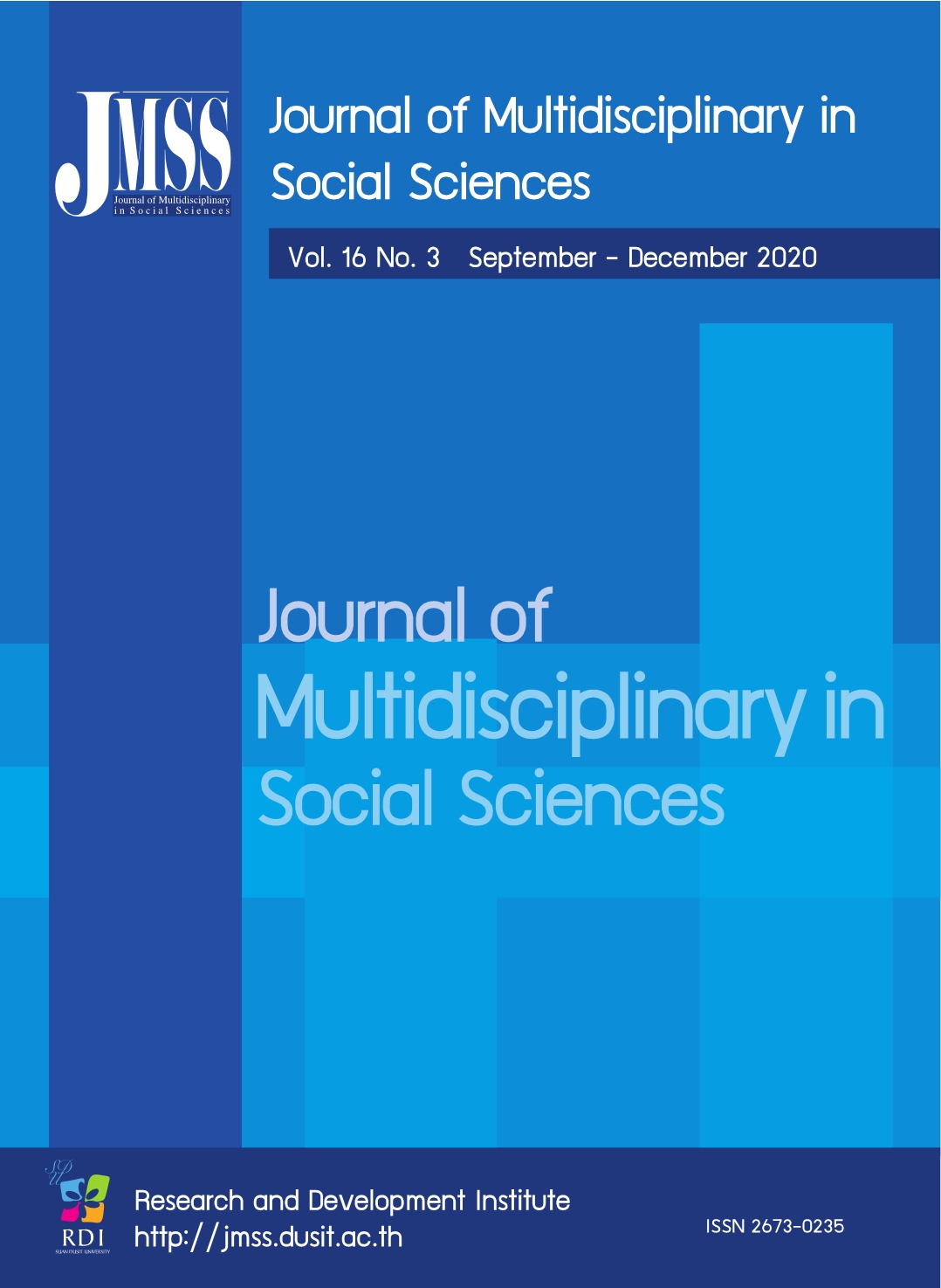Theoretical Perspectives on Aging Workforce
Keywords:
Theoretical perspectives, Aging workforce, Post-retirement employmentAbstract
The raising of the aging population that comes with the reduction of the workforce population is the problem that the world will have to encounter in the near future. The measure that are applied to cope with the mentioned situation is to encourage the elderlies to continue to work and help maintain the academic growth and reduce the pension problem caused by the imbalance between the workforce populations and the retirees that keep increasing each year. For the mentioned measure is a new thing for Thai society, this article aims to reflect the theoretical point of view from the experience in western society which have entered the Aging Society before Thailand in the issue related to working after retirement to the fundamental concept in human resource management in the changing situation of the population structure and workforce in Thailand.
References
Ajzen, I. (1991). The theory of planned behavior. Organizational behavior and human decision processes, 50(2), 179- 211.
Ashforth, B. E. (2001). Role Transitions in Organizational Life: An Identity-based Perspective. New Jersey: Lawrence Erlbaum Associates Publishers.
Atchley, R. C. (1989). A Continuity Theory of Normal Aging. The Gerontologist, 29(2), 183-190.
Bal, A. C., Reiss, A. E. B., Rudolph, C., & Baltes, B. (2011). Examining Positive and Negative Perceptions of Older Workers: a Meta-analysis. Journals of Gerontology Series B: Psychological Sciences and Social Sciences, 66(6), 687-698.
Baltes, M. M., & Baltes, P. B. (1990). Psychological Perspectives on Successful Aging: The Model of Selective Optimization and Compensation. In P. B. Baltes & M. M. Baltes (Eds.), Successful aging: Perspectives from the behavioral sciences, (1-34). New York: Cambridge University Press.
Beach, L. R., & Frederickson, J. R. (1989). Image Theory: An Alternative Description of Audit Decisions. Accounting, Organizations, and Society, 14(1-2), 101- 112.
Böhm, S. A., Kunze, F., & Bruch, H. (2014). Spotlight on Age Diversity Climate: the Impact of Age-Inclusive HR Practices on Firm-level Outcomes. Personnel Psychology, 67(3), 667-704.
Cattell, R. B. (1963). Theory of fluid and crystallized intelligence: A critical experiment. Journal of Educational Psychology, 54(1), 1-22.
Costa, P. T., & McCrae, R. R. (1992). NEO PI-R Professional Manual. Florida: Psychological Assessment Resources.
Elder, G. H., & Johnson, M. K. (2003). The Life Course and Aging: Challenges, Lessons, and New Directions. In Settersten, Jr, R. A. (Ed.), Invitation to the Life Course: Toward New Understandings of Later Life. New York: Baywood.
Finkelstein L. M., Burke M. J., & Raju N. S. (1995). Age discrimination in simulated employment contexts: an integrative analysis. Journal of applied psychology, 80(6), 652.
Gustman, A. L., & Steinmeier, T. L. (1986). A Structural Retirement Model. Econometrica, 54, 555-584.
Hansson, R. O., DeKoekkoek, P.D., Neece, W. M., & Patterson, D. W. (1997). Successful aging at work: Annual review, 1992-1996: The older workers and transitions to retirement. Journal of Vocational Behavior, 51(2), 202-233.
Hertel, G., & Zacher, H. (2018). Managing the Aging Workforce. Retrieved April 5, 2020, from https://www.researchgate.net/publication/277872717_Managing_the_aging_workforce
Jussim, L. (2001). Self-fulfilling Prophecies. In International Encyclopedia of the Social & Behavioral Sciences. Retrieved April 12, 2020, from https://www.sciencedirect.com/topics/social-sciences/selffulfilling-prophecy
Kunze, F., Böhm, S. A., & Bruch, H. (2011). Age Diversity, Age Discrimination Climate and Performance Consequences: A Cross Organizational Study. Retrieved June 8, 2020, from https://onlinelibrary.wiley.com/doi/abs/10.1002/job.698
Lawrence, B. S. (1988). New Wrinkles in the Theory of Age: Demography, Norms, and Performance Ratings. Retrieved June 8, 2020, from https://www.jstor.org/stable/256550?seq=1
Malee, S. (2018). How to Prepare the Governmental Sector’s Manpower towards Aging Society?: Tracing National Strategies and Country Reform Plans. Civil Servant Journal, 60(4), 9-11.
McAdams, D. P., & de St. Aubin, E. D. (1998). Generativity and adult development. Washington, DC: American Psychological Association.
McClearn, G. E., Johansson, B., Berg, S., Pederson, N., Ahern, F., Petrill, S. A., & Plomin, R. (1997). Substantial Genetic Influence on Cognitive Abilities in Twins 80 or More Years Old. Science, 276(5318), 1560-1563.
Ng, T. W. H., & Feldman, D. C. (2012). Evaluating Six Common Stereotypes about Older Workers with Meta-analytic Data. Retrieved June 15, 2020, from https://onlinelibrary.wiley.com/doi/abs/10.1111/peps.12003
O’Reilly, C. A., Caldwell, D. F., & Barnett, W. P. (1989). Work Group Demography, Social Integration, and Turnover. Administrative Science Quarterly, 34(1), 21-37.
Pengcharoan, C., & Shultz, K. S. (2010). The Influences on Bridge Employment Decisions. International Journal of Manpower, 31(3), 322-336.
Perry, E. L., Kulik, C. T., & Bourhis, A. C. (1996). Moderating Effects of Personal and Contextual Factors in Age Discrimination. Journal of Applied Psycholog, 81(6), 628-647.
Ready, B. (2012). Aging and Emotions. Retrieved April 15, 2020, from https://www.psychologytoday.com/us/blog/your-quality-life/201208/aging-and-emotions
Secretariat of the House of Representatives. (2018). Aging Society and Thai Economic Driven. Retrieved April 2, 2020, from http://www.parliament.go.th/library
SHRM Foundation. (2014). The Aging Workforce. Retrieved June 8, 2020, from https://www.shrm.org/ResourcesAndTools/hr-topics/behavioral-competencies/global-and-cultural-effectiveness/Documents/7-14%20Roundtable%20Summary.pdf
Siriphanish, B. (2007). Handbook for the Elderly: Preparation to Retirement. Bangkok: Moachauwbann.
Streubel, B., & Kunzmann, U. (2011). Age Differences in Emotional Reactions: Arousal and Age-relevance Count. Psychology and Aging, 26(4), 966-978.
Thatcher, S. M. B., & Patel, P. C. (2012). Group Faultlines: A Review, Integration, and Guide to Future Research. Journal of Management, 38(4), 969-1009.
Truxillo, D. M., Cadiz, D. M., & Rineer, J. R. (2014). The Aging Workforce: Implications for Human Resource Management Research and Practice. Oxford: Oxford University Press.
Wegge, J., Roth, C., Neubach, B., Schmidt, K. H., & Kanfer, R. (2008). Age and Gender Diversity as Determinants of Performance and Health in a Public Organization: The Role of Task Complexity and Group Size. Journal of Applied Psychology, 93(6), 1301.
Weiss, E. M., & Maurer, T. J. (2004). Age Discrimination in Personnel Decisions: A Reexamination. Journal of Applied Social Psychology, 34(8), 1551-1562.
Downloads
Published
How to Cite
Issue
Section
License

This work is licensed under a Creative Commons Attribution-NonCommercial-NoDerivatives 4.0 International License.








